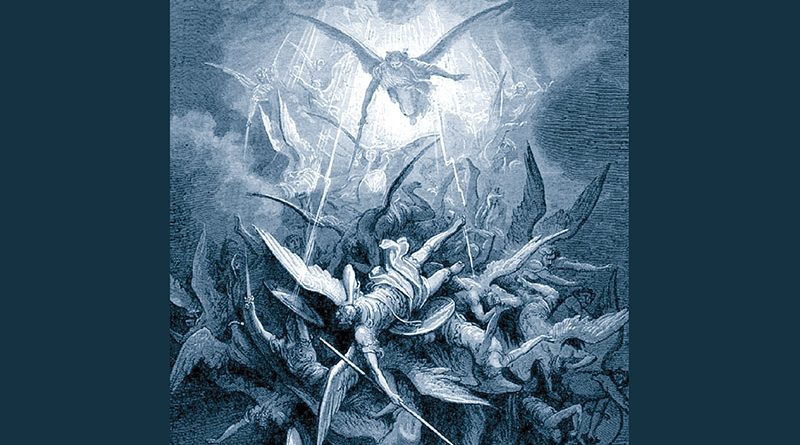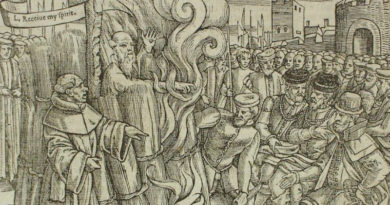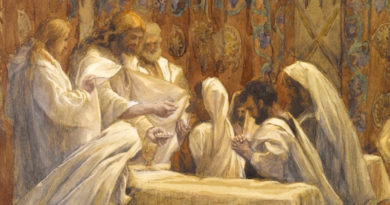To Beat Down Satan
By Derek Neal
NATHANIEL, meeting Jesus at the beginning of his earthly ministry, was surprised that Jesus knew his name, and instantly declared Jesus to be who he really was and is: Son of God and King of Israel. Jesus responded that Nathaniel would see greater things: “heaven open, and the angels of God ascending and descending upon the son of Man.” Heaven and earth are not cut off from each other but in constant connection, conversation.
That moment between Jesus and Nathaniel showed that the connection between heaven and earth had reached a new stage, as Jesus prepared to undertake his life of living the good news of God’s love among humankind. Now, as we stand with St John and behold his great Revelation, the vision of the summing-up of all things, Jesus’ words have been fulfilled for us as well: we too, together with St John, see heaven open, and we see angels.
The angels we see (without really knowing how they look) are familiar beings in Scripture. Usually, we have met them as messengers, whether in human form (like the men who came to Abraham and Sarah) or some other. In fact, “messenger” is the real meaning of the Greek word from which we get our word “angel.” They bring messages from God, like that of the angel Gabriel to Mary. Or they bear witness to God through their praising and rejoicing, like those who appeared to the shepherds.
The angels described by St John in Revelation bear witness in a very different way. They are warriors in a great battle.
All of Revelation, effectively, is the opening-up of heaven to St John, his seeing heaven open. That’s why it is also known as the Apocalypse, the showing-forth of what has been hidden. We must remember that John saw in signs and symbols. The strange images of Revelation are not literal descriptions; they convey the meaning of heavenly things – what they are like, so that human minds can at least begin to understand.
In the earlier part of the book, John has described his vision from inside heaven, where he found himself in the very presence of God as in a great throne room, God worshipped by other heavenly beings. Now the standpoint changes. You may have had dreams where the point of view abruptly changed like a cut in a film. Much like that, John now finds himself looking at heaven, or the heavens, from earth. He sees there, as if on a screen, a great drama of battle played out.
This battle drama, a drama of “wonders” in the sky, begins with a woman, magnificently clothed but crying out with labour pains. She is confronted by an enormous red dragon who waits to devour the child she will deliver. The woman bears “a man child, who was to rule all nations with a rod of iron” (Revelation 12.4, KJV), but the dragon is thwarted: the child is “caught up unto God, and to his throne,” and the woman escapes into the wilderness where God prepares her a refuge.
Who are this woman and her child? She represents several things simultaneously. She is Daughter Zion, the nation of Israel as God sees her, bringing forth the Messiah. She represents Mary, mother of our Lord. And she is also the Church, bearer of Christ to the world. The forces of evil represented by the dragon would like nothing better than to destroy the child. But the dragon’s first attempt, to squelch this new hope immediately, has failed.
And this same dragon now engages in battle with “Michael and his angels,” and the dragon is cast out of heaven and falls to the earth.
Michael appears several times in Scripture, as the leader of the forces that will defend and redeem God’s people. The author of Daniel, whose visions came at a time of terrible oppression of the Jewish people, saw Michael as the heavenly one who would lead the fight for Israel’s liberation, even though that would mean “a time of trouble, such as never was since there was a nation even to that same time” (Daniel 12.1). And so there was– in the Maccabean War. But Daniel also saw Michael involved in a cosmic battle at the end of time, with the resurrection of the dead and a final judgment. That is the vision granted to St John in much greater detail, in Revelation. The image of Michael as the leader of heavenly armies means that in European art he often appears as a humanoid angel, like a medieval knight, a warrior in armour, with a great spear in his hand. This is only a way of imagining him, of course, that conveys his role in the cosmic battle.
With Michael in charge, the dragon and his angels are cast out of heaven. It might seem strange that they were ever there, but “heaven” here does not mean the state of bliss in God’s presence that we imagine. It means something more like “the heavens”: the place beyond, the place of supernatural forces, in contrast to the earth, where humans and mortal beings reside. The book of Job, for example, possibly one of the oldest texts in our Bible, had no problem imagining Satan hanging around with God and the other heavenly beings. Now, the dragon’s defeat means that he no longer has any place in that heavenly realm, no place among the beings beyond human understanding (Revelation 12.8). He falls to the earth. He has not been killed, nor has he been completely stripped of his power, but he has no mystery left. He is unmasked as “that old serpent called the Devil, and Satan, that deceiveth the whole world” (Rev. 12.9). He has become nothing but a nuisance, albeit potentially a great one, and his days are numbered.
Heaven resounds in a victory cry, the announcement of “salvation, and strength, and the kingdom of our God, and the power of his Christ” (Rev. 12.10). And now St John sees what the battle, and the victory, mean. It was a battle waged on behalf of humankind, “our brothers and sisters.” And humankind was actually involved.
How do we know this? The voice in the vision says that “they” – “our brothers and sisters” – “overcame” the dragon “by the blood of the Lamb, and by the word of their testimony” (Rev. 12.11). Earlier, St John has already seen the Lamb, representing Jesus’ self-sacrifice, worshipped in heaven. He has also seen an enormous crowd that no one could number, described as “the ones who have come out of the great tribulation.” These are followers of Jesus who have endured persecution for his sake, and John is told, “they have washed their robes and made them white in the blood of the Lamb” (Rev. 7.14). Their sharing in his death, his blood, has been their glory. And now John sees that the truth is even greater: these who have followed Jesus even to death, who “did not love their lives so much that they were afraid to die” (Rev. 12.11), have by that self-sacrifice actually participated in bringing the devil down to earth, in cutting him down to size. So, the victory of Michael and his angels is the victory also of those who have given themselves to Christ who died for them. In a very real sense, Michael and his angels stand for Christ and his own, the great multitude that is Christ’s Church throughout time. Their victory is Christ’s victory.
For it is in Christ that the devil is most clearly shown to be a liar, a deceiver, an accuser. The devil’s aim, from the beginning, has been to get between God and humanity, to subvert God’s intention for his entire creation of which humanity is meant to be the crown. All the devil’s works, including those that lead humanity to abuse the rest of the creation, have this same aim. The devil declares that there is nothing more powerful than death – whether of the body or the self or the self-image – and so anything that preserves the self, at any cost, is permissible. The devil accuses humanity, reminding us perpetually of our failings, telling us we are incapable of good and unworthy of love, and that God is no use.
Yet God’s work in Jesus aims directly to overcome this set of lies. Hence God’s earthly life in the man Jesus, reaches to the most wretched of the world to overturn their degradation. God’s great self-emptying in Jesus, assuming the shame of the cross, is a self-giving that makes a mockery of self-preservation, just as Jesus’ resurrection made a mockery of the power of death. St John’s vision affirms that by faith in Christ, and participation in his sufferings, the Church acts to bring down the devil.
The Church (that means you and me, all of us together) is caught up into Christ’s battle, a battle that is in time and out of time. St John saw a future event at the end of time in the cosmic sense. But that cosmic scale takes in the present, our present, also. St John saw the battle summed up, as it were, as a drama in the heavens. Yet the battle goes on. The devil, cast down, knows he has but a short time, and therefore has “great wrath.” And the very next verse says that “when the dragon saw that he was cast unto the earth” – as if picking himself up and looking around – “he persecuted the woman which brought forth the man child” (Rev. 12.13). The woman is protected from the dragon and he does not catch her. But he goes “to make war with the remnant of her seed, which keep the commandments of God, and have the testimony of Jesus Christ” (Rev. 12.17).
The Church, the heavenly army, acts to bring down the devil, and the devil pursues the Church, the woman who brings forth the child. Ultimately the devil’s pursuit is futile. But it still means no rest for the Church until the final battle is won. The good news is that having seen the end, we know the outcome. We know that our defeat in the short run is only temporary. And we know, too, that our identity is as followers of Christ, as those who fight under the banner of St Michael. We are not the generals. We follow.
Many Christians are uncomfortable with the language and imagery of battle in passages like this. That is to their credit, since it means an awareness of the terrible sin of human war. But remember, the battle described here is in heaven, not on earth. We have little difficulty describing ourselves as “fighting” a disease, or conceiving of the white blood cells in our bodies “fighting” an infection so that we may live. The battle envisioned by St John is as unlike a human war, on just as dissimilar a plane of existence, as a human war is unlike the process fighting infection inside the body. They are leagues, galaxies, apart. Especially since the followers of Christ fight by refusing to preserve themselves, by giving themselves up for his sake.
They overcame the dragon by the word of their testimony. We are called to be angels – messengers and therefore warriors – through being evangelists, witnesses to Christ. The Litany in the Book of Common Prayer asks that we may “finally beat down Satan under our feet.” In whatever ways we imitate Christ, in whatever ways we show the world self-giving love, the word of that testimony goes forth and we fight as if under Michael, the very figure of Christ. TAP
The Rev’d Dr Derek Neal is the Incumbent of Holy Trinity Anglican Church, Témiscaming, Quebec and St Simon’s Anglican Church, Temagami, Ontario.




